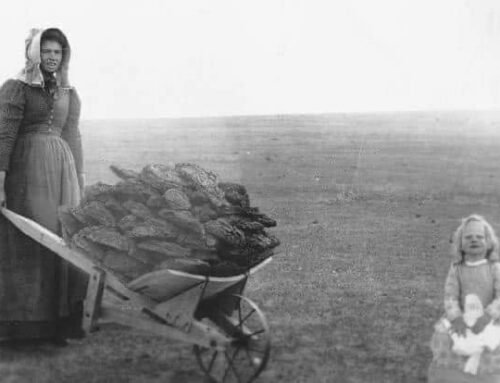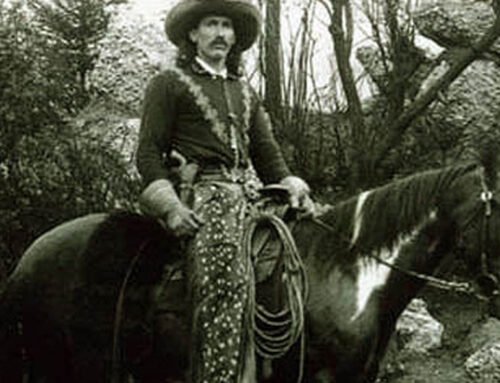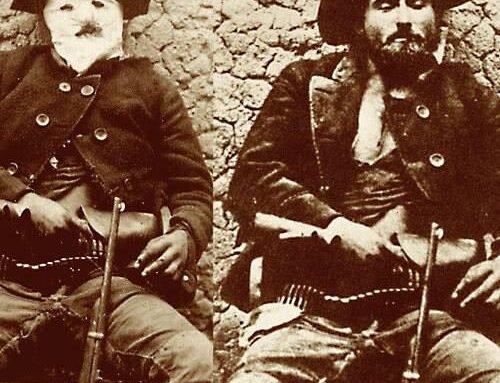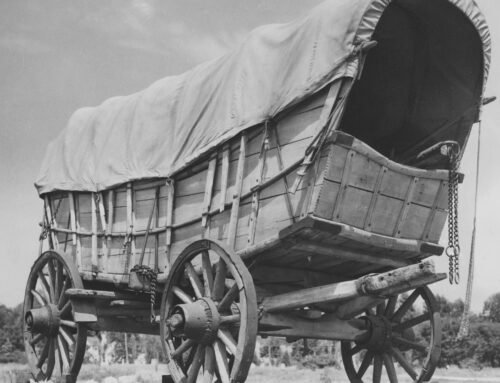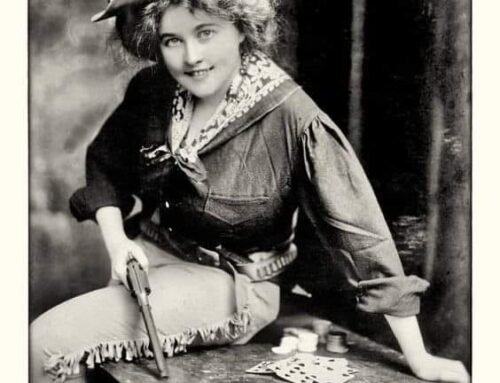Cowboy boots – a history
By western author Nick Brumby
“Cowboy boot (noun): a boot made with a high arch, a high Cuban heel, and usually fancy stitching”
— Miriam Webster Dictionary
 The cowboy boot story is as long and winding as the Goodnight Loving Trail. They often have more personality than the cowpoke wearing them.
The cowboy boot story is as long and winding as the Goodnight Loving Trail. They often have more personality than the cowpoke wearing them.
Cowboy boots are more than just footwear – they are a way of life. And no high-falutin’ fancy words or dictionary definition will ever capture just what the cowboy boot meant to those who rode across the Old West.
Like a cowboy, they were tough. Practical. Reliable. Took punishment without complaint. And just like a cowboy, they could be more than a little rough around the edges.
Leather riding boots go way back. The earliest historical mention of a “leather boot” can be traced back to the 11th Century when Genghis Khan invaded Europe with his Mongol hordes. Accounts from the time say he wore distinctive red leather boots with wooden heels.
As centuries went by, leather riding boots slow spread across Europe. However, it wasn’t until the 17th and 18th Centuries that English riding boots brought leather, high tops and stacked heels back into popularity.
Hessian boots were a popular aspect of calvary uniforms in Europe during the 19th century. These boots had a tall shaft, rounded toe and a slight heel.
 Though today’s Wellington boots are tall rubber rain boots, the original style was quite different. Named after the Duke of Wellington, the original Wellington was like a modified Hessian boot. They had a slightly shorter shaft, rounded toe, slight heel and were more practical than Hessian boots.
Though today’s Wellington boots are tall rubber rain boots, the original style was quite different. Named after the Duke of Wellington, the original Wellington was like a modified Hessian boot. They had a slightly shorter shaft, rounded toe, slight heel and were more practical than Hessian boots.
The American cowboy boot itself was inspired by the vaquero-style boot brought to the Americas from Spain in the 1600s. Americans most likely adopted cowboy boots from riders hailing from Northern Mexico, while military boots designed for cavalry riders also had an influence. Mexican vaqueros probably developed cowboy boots from the Spanish riding boots.
Mexican cowboy boots only came in three styles, rounded toe, pointed toe, and tribal toes, while the idea of using skins on the boots came from Northern Mexico. Boot colors were chosen to imitate the colors of Mexican ranches.
Originally, riding boots were handmade. Later, the Industrial Revolution allowed some styles of boots to be mass-produced. One mass-produced boot style, the Wellington boot (a shorter but cavalry-oriented boot), was popular with cowboys in the US until the 1860s. After the Civil War, the military boot fell out of style and the classic cowboy boot came into vogue as many former soldiers went west to farm, herd cattle, and pioneer new towns.
 But unlike cavalry riders who rode on the balls of their feet, cowboys ride on their instep. This is what led directly to the crucial invention that created the ‘cowboy boot’ – sewing a steel shank between layers of leather to create a supported instep in the boots.
But unlike cavalry riders who rode on the balls of their feet, cowboys ride on their instep. This is what led directly to the crucial invention that created the ‘cowboy boot’ – sewing a steel shank between layers of leather to create a supported instep in the boots.
This development was critical in that, as cowboys rode with their feet in the stirrups of their saddles, wearing boots with a sturdier instep made riding more comfortable. In doing so, the addition of the supported instep allowed cowboys to ride for longer periods of time.
No one really knows who exactly the first person was to create a pair of ‘cowboy boots’. We know the first pair of western boots took the stage around 1865 in Kansas or Texas. The American-style boot was taken up by bootmakers in the cattle ranching areas of Texas, Oklahoma, and Kansas. Two of the best-known early bootmakers of the era were Charles Hyer of Hyer Brothers Boots in Olathe, Kansas, and H. J. “Daddy Joe” Justin of Justin Boots in Fort Worth, Texas and later Nocona, Texas.
Cowboy boots are designed for work. Every single detail or feature has a use and make it easier for a cowboy to do their job – to move and manage cattle.
The ‘classic‘ style of cowboy boot is tall and hugs your calf. Cowboy boots protect your foot, ankle and calf, and keep the rider’s foot firmly anchored in the stirrups while riding. The boot’s angled heel sits securely in the bottom of the stirrup so as to prevent it slipping out. Any stitching on the outside of the boot keeps the leather from bending and holds a firm shape around the leg instead of folding over.
 The tall leather shaft of a cowboy boot holds it in place without requiring lacing. The tall shaft, comfortable fit, and lack of lacing all help to stop a cowboy from being dragged if he falls from his mount. This is vital, since his body weight could pull his foot out of the boot if he falls off while his boot remains stuck in the stirrup. When mounted, the shaft also protects the lower leg and ankle from rubbing on the stirrup leathers, as well as fending off brush and thorns. When standing on the ground, the shaft helps protect the cowboy’s leg and foot from rocks, brush, thorns, and rattlesnakes.
The tall leather shaft of a cowboy boot holds it in place without requiring lacing. The tall shaft, comfortable fit, and lack of lacing all help to stop a cowboy from being dragged if he falls from his mount. This is vital, since his body weight could pull his foot out of the boot if he falls off while his boot remains stuck in the stirrup. When mounted, the shaft also protects the lower leg and ankle from rubbing on the stirrup leathers, as well as fending off brush and thorns. When standing on the ground, the shaft helps protect the cowboy’s leg and foot from rocks, brush, thorns, and rattlesnakes.
The classic cowboy boot typically has an angled “cowboy” heel, usually more than an inch high. A slightly lower (but still angled) “walking” heel is also common. Cowboy boots are normally made from cowhide leather, which can have decoratively stitching, but are also made from exotic skins like alligator, snake, ostrich, lizard, and so on.
 When mounting (and particularly, dismounting) the slick leather sole of the cowboy boot allows the rider to easily insert into and remove their foot from the stirrup. The original toe was rounded and slightly narrowed at the toe to make it easier to insert. The narrow pointed-toe design appearing during in the early 1940s.
When mounting (and particularly, dismounting) the slick leather sole of the cowboy boot allows the rider to easily insert into and remove their foot from the stirrup. The original toe was rounded and slightly narrowed at the toe to make it easier to insert. The narrow pointed-toe design appearing during in the early 1940s.
While in the saddle, the tall heel minimizes any chance of the cowboy’s foot sliding forward through the stirrup. This can be life-threatening if the rider is unseated. Cowboys often had to ride young, unpredictable horses, and he had to do challenging ranch work in rugged terrain. This mean that he could accidentally fall off a skittish horse. If a rider fell but had a boot caught in the stirrup, there is a chance that the horse could panic and run off, dragging the cowboy, thus causing severe injury and possible death.
Cowboy boot decoration has come a long way. Early boots were cowhide leather pieced together with single rows of topstitching. As time went on, cowboys asked for decorative stitching, cutouts in the high tops (such as Texas stars), and different materials.
Toe styles have varied over the years, but the basics have not changed. Popular toe styles include snip, wide snip, square, and round.

Things changed somewhat the 1930s and 40s, when the influence of Hollywood and growing popularity of Western films brought a whole new dimension to cowboy life in general—and to cowboy boots in particular.
What began as pure practicality evolved into a fashion statement. While maintaining their practical function, plain cowboy boots gave way to colorful stitching and sewn-on designs and pictures. Bootmakers began experimenting with hand tooling, patterned stitching, and colorful designs to keep up with the demand inspired by the “fashion-forward” boots worn by John Wayne and Gregory Peck.
Shoemakers began experimenting with different stitching styles and dyed leathers to create pairs of boots that stood out to buyers. Today there are seemingly endless heel heights, leathers, stitch designs, and toe shapes to choose from.

About Nick Brumby
I like a good story. And of all stories, I love westerns the most.
As a kid, I spent far too many afternoons re-watching Clint Eastwood spaghetti westerns, picking up ‘Shane’ for just one more read, or saddling up beside Ben Cartwright when ‘Bonanza’ was on TV each afternoon.
I’m a former journalist and I love horses, dogs, and the occasional bourbon whiskey. I live with my wife, daughter and our ever-slumbering hound in a 1800’s-era gold mining town – our house is right on top of the last working gold mine in the area. There may not be much gold left, but there’s history wherever you look.
I hope you enjoy my westerns as much as I enjoyed writing them!
Happy trails,
Nick






















